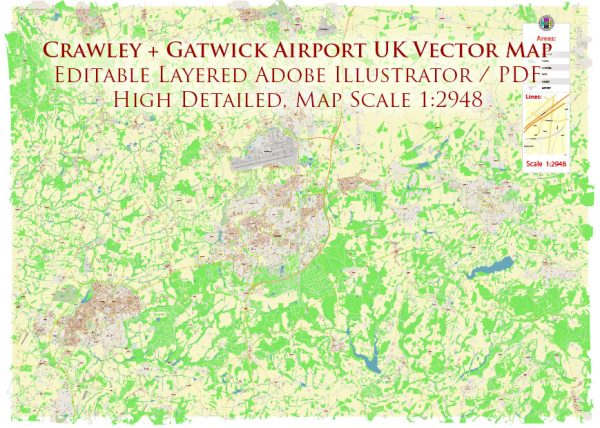Crawley, a town in West Sussex, England, is closely associated with the development and growth of Gatwick Airport, one of the busiest airports in the United Kingdom. The history of Crawley’s urban development is intricately linked to the expansion and evolution of Gatwick Airport.
- Pre-Aviation Era:
- Before the airport, Crawley was a small market town with a history dating back to the Saxon period. Its growth was relatively slow, and it primarily served as an agricultural and market center.
- Aviation Development:
- The development of Gatwick Airport started in the late 1920s, with the land initially used for flying activities. During World War II, the Royal Air Force used Gatwick as a base, significantly influencing the town’s landscape and development.
- Post-War Expansion:
- After the war, Gatwick transitioned into a civilian airport. The demand for air travel increased steadily, leading to the expansion of both the airport facilities and the town of Crawley. The population surged as people associated with the aviation industry moved to the area.
- New Town Status:
- In 1947, Crawley was designated as a New Town under the New Towns Act of 1946, aimed at alleviating housing shortages in urban areas. This status brought significant planning and development to Crawley, transforming it into a more modern and functional town.
- Economic Impact:
- The presence of Gatwick Airport brought economic prosperity to Crawley. The aviation industry, including airport-related services, hotels, and businesses, became vital contributors to the local economy. The town’s infrastructure, including transportation networks, schools, and healthcare facilities, developed in response to the increasing population.
- Infrastructure Development:
- The expansion of Gatwick Airport necessitated improvements in transportation links. Crawley became well-connected with major roads and public transport, facilitating not only airport access but also enhancing the town’s connectivity to surrounding areas.
- Employment Opportunities:
- Gatwick Airport became a major employer in the region, offering job opportunities in various sectors, including aviation, hospitality, and retail. This contributed to Crawley’s economic stability and diversity.
- Modern Challenges:
- The success and growth of Gatwick Airport and Crawley, however, have presented challenges such as congestion, environmental concerns, and the need for continued infrastructure development to accommodate the increasing demands of air travel.
- Diversification of Economy:
- In recent decades, efforts have been made to diversify Crawley’s economy beyond its dependence on aviation. This includes the development of business parks, technology hubs, and other industries to ensure long-term economic sustainability.
In summary, the history of urban development in Crawley is closely intertwined with the rise of Gatwick Airport. From a small market town, Crawley transformed into a vibrant and economically significant center, largely driven by the aviation industry’s growth and the subsequent development of the airport.


 Author: Kirill Shrayber, Ph.D.
Author: Kirill Shrayber, Ph.D.